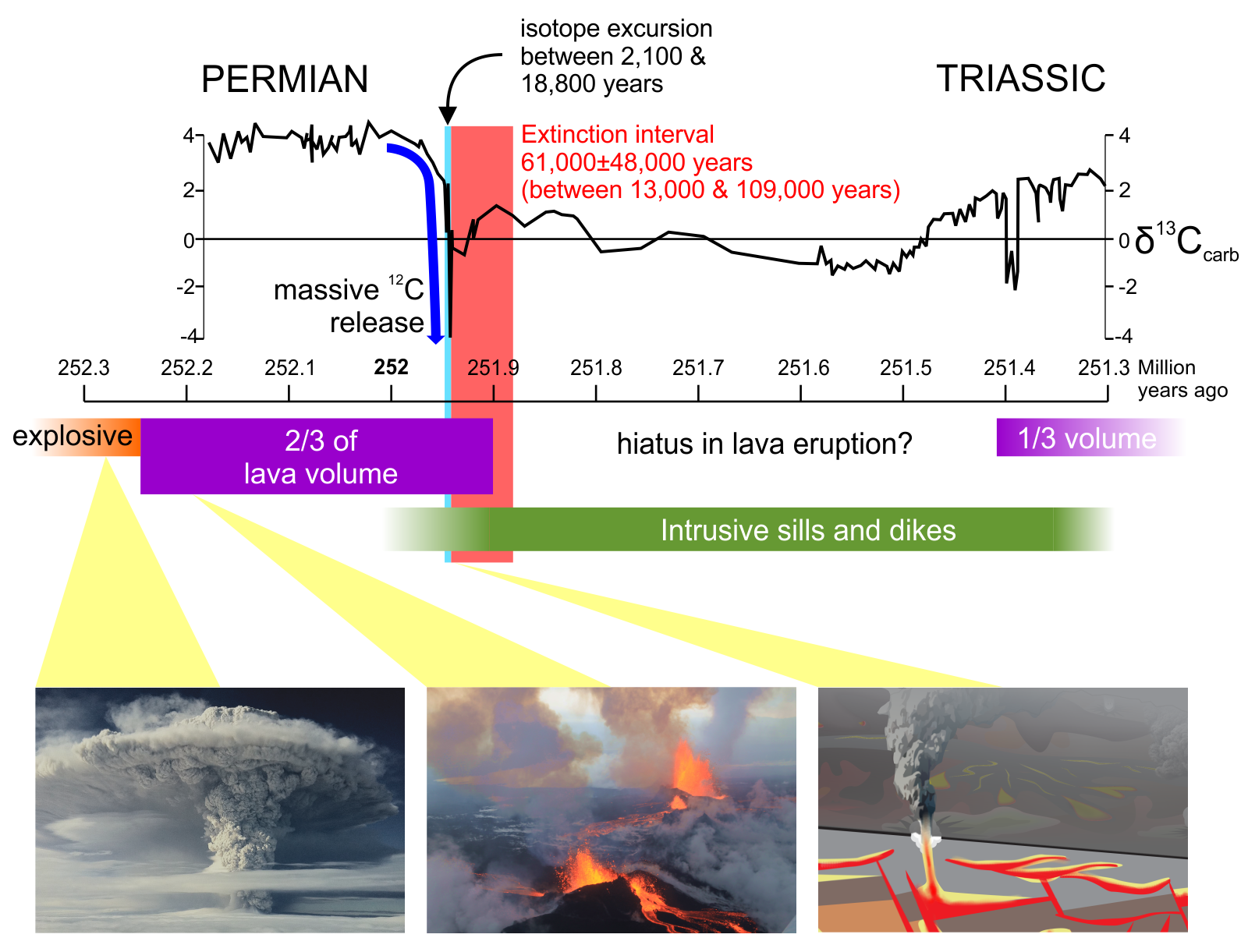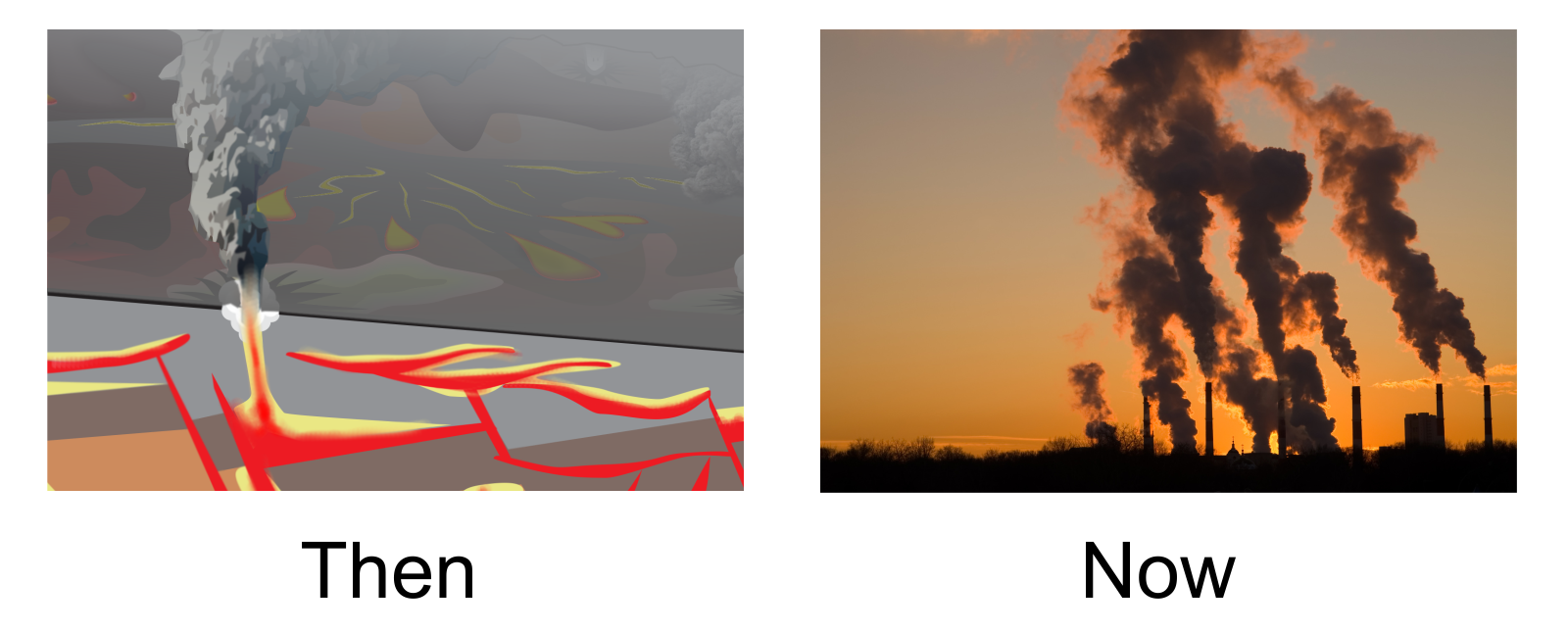
The latest batch of rock dates released by the MIT geochronology team "inescapably" nails the link between the end-Permian Siberian Traps eruptions and Earth’s worst mass extinction, pointing to the critical role of greenhouse gasses in the catastrophe.
Seth Burgess and Samuel Bowring confirmed the long-hypothesized link by comparing new, high-precision dates from volcanic rocks with equally precise dates for the mass extinction measured from volcanic ash in sediments spanning the end-Permian boundary in China. By ensuring the same labs and chemical tracers were used in both sets of measurements, they were able to compare the dates at an unprecedented precision of 0.04% or better, even though the rocks sampled were from locations thousands of miles apart.
The Siberian Traps are an example of a rare geological phenomenon called a “Large Igneous Province” (LIP) which has been linked to 4 out of the “big 5” mass extinctions since animals evolved. The new timeline enables science to zoom in to the details of the terrible events 252 million years ago, in which more than 90% of marine, and some 75% of land life went extinct.

Timeline of Earth’s worst mass extinction. Redrawn and simplified from Burgess & Bowring 2015, annotations and photos added.
The LIP began with explosive eruptions around 252.3 million years ago, as magma and lava encountered waterlogged, swampy terrain. These eruptions blanketed the region in volcanic ash, in some areas building to a kilometer thick. Then at 252.24 million years ago, lava flows took over: curtains of bright lava gushed from fissures, emitting CO2 and SO2, before flowing through lava tubes to advancing lava fronts. Fully 2/3 of the entire Siberian Traps lava sequence erupted this way over 300,000 years, building to 4 km thick of stacked lava flows that form the “traps” landscape of the Siberian Traps today. That’s some 3 million cubic kilometers of magma – with associated gasses - erupted before and at the onset of the mass extinction.
The end-Permian mass extinction began towards the end of those lava eruptions, at the same time as a huge spike in the carbon isotope balance, indicating that massive amounts of CO2 and/or methane were released into the atmosphere and oceans from an exponentially growing pool rich in carbon-12. The rapidity of this isotope “excursion” strains the limits of even the new dating resolution, with a duration somewhere between 2,100 and 18,800 years. The smaller of those numbers is a mere 2 complete ocean circulations at today’s rates, fewer if circulation was more sluggish in the Permian. This matters because we expect abrupt global warming and ocean acidification if CO2 emissions overwhelm the oceans’ capacity to process them, as explained in this article.
Since life preferentially stores carbon-12 over carbon-13, this suggests that a large reservoir of once-living carbon was rapidly converted to CO2. Alternatively, it might indicate a mantle source unusually rich in carbon-12.
The mass extinction unfolded for about 61,000 years into the early Triassic. The uncertainty on the extinction episode means it might have been as short as 13,000 or as long as 109,000 years – a timespan during which complex life on Earth was nearly wiped out by the deteriorating environment and climate change.
Over the years leading into the mass extinction the oceans gradually became more acidic, resulting in the loss of shelly, carbonate producing animals, and leaving sea beds dominated by sponges. Then at the carbon isotope excursion even the sponges disappeared as the environment became heavily polluted. The terrestrial extinction happened at the same time, as acid rain fell and global temperatures soared some 10°C. As the seas warmed they became starved of oxygen so that even the worms that burrowed in the seabed disappeared. Temperatures remained high well into the Triassic, and it took 10 million years for biodiversity to recover.
As Burgess and Bowring point out, these symptoms:
“…all point to anomalously high atmospheric pCO2 as a critical driver of both terrestrial and marine biotic crises”
The mystery is: what triggered the massive carbon release in the final few millennia of the eruptions, rather than any time in the preceding 300,000 years? As Burgess and Bowring say:
“The enormous total volume of LIP magmas might be less important than an aliquot of the total, erupted/emplaced in a very restricted interval.”
It may be that the progressive degradation of the Permian conditions brought the environment to a tipping point, such as the destabilization of methane clathrates in the oceans. But a recent study suggests that by the end-Permian reserves of marine clathrates were largely tapped-out.
Burgess and Bowring suggest an alternative scenario:
“Early sill intrusion into, and magma transport through an untapped, volatile-rich basin may be this critical aliquot."
They dated the Noril’sk 1 underground igneous intrusion - the oldest found anywhere in the Siberian Traps – as beginning around same time as the carbon isotope excursion. Noril’sk 1 marks the beginning of a new phase of the eruptions – the injection of many underground sheets of magma (“sills” and “dikes”) into the Tunguska sedimentary basin, a thick sequence of sedimentary rocks containing fossil fuels. Some sills reach 350 meters thick and extend great distances, and cumulatively the intrusions exceed 2 million cubic kilometers of magma.
Svensen et al showed in 2009 that these sills baked coal, oil and natural gas, salt, limestone, and organic-rich shales in the sediments, generating large volumes of methane and CO2, as well as a cocktail of noxious gasses, acids, ozone-eating chemicals and coal fly-ash. These gasses exploded into the atmosphere through thousands of pipe eruptions across Siberia, belching columns of gas and pollutants from vents up to 1.6 km wide, leaving behind mineral-rich pipes that are mined for iron ore today.
Earlier this year Fristad et al published a study of the carbon chemistry of one of those pipes, which showed that the carbon involved in its formation was indeed rich in carbon-12, strongly linking Permian pipe eruptions with the massive release of carbon-12 recorded in the isotope excursion.
Noril’sk 1 was amazingly long-lived, having 3 distinct magma injections over some 267,000 years. But many of the observed Siberian sills and dikes are dated to after the mass extinction, a time when the carbon isotope curve shows only minor variation. It may be that the sediments had limited reserves of carbon to bake-off. Within a few thousand years their fossil fuel reserves may have been exhausted.

As I outlined in this earlier article, emission rates matter a lot when it comes to our oceans’ ability to process them. Some LIPs, like the Paraná-Etendeka LIP, erupted slowly without causing environmental destruction and global climate change. These new dates suggest that the initial phase of the Siberian Traps had a relatively modest effect on the global environment, but later on during the eruptions, probably when widespread sill intrusions occurred and greenhouse gasses from baking of sediments were added to the load, this appears to have overwhelmed the already-stressed environment.
The irony is that back in the Permian the combustion of fossil fuels contributed to global warming and an environmental catastrophe so extreme that it came close to extinguishing complex life. Today we are embarking down a similar path, emitting at rates probably faster than in the end-Permian, even though our total emission quantities are smaller.
As new dates keep resolving the timeframes for these epoch-changing events in Earth’s past to ever-briefer intervals, their similarities with modern climate change increase. If Earth responded in a similar manner several times in its past, it is crucial that we focus research on understanding just how similar our modern path is, and how far along it we have already travelled, because the destination isn’t exactly a picnic spot.
Posted by howardlee on Wednesday, 14 October, 2015
 |
The Skeptical Science website by Skeptical Science is licensed under a Creative Commons Attribution 3.0 Unported License. |